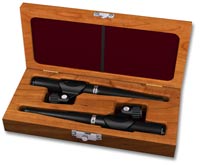Earthworks SR77 Review – Down Beat
Earthworks SR77 Cardioid Condenser Mics: Detailed Sound
by Seth Greene
 Earthworks’ SR77 cardioid condenser mics [Now known as the SR30 –Ed.] are the company’s latest offering for the pro audio market. Out of the box the frequency response chart showed less than half a db divergence (from 1kHz all the way to 30kHz) between the pair of mics I reviewed. The enclosed literature also mentions a very high SPL handling capability and very hot output signal.
Earthworks’ SR77 cardioid condenser mics [Now known as the SR30 –Ed.] are the company’s latest offering for the pro audio market. Out of the box the frequency response chart showed less than half a db divergence (from 1kHz all the way to 30kHz) between the pair of mics I reviewed. The enclosed literature also mentions a very high SPL handling capability and very hot output signal.
After setting up the pair as overheads on a simple drumset (with 3 feet of separation), I noticed beautiful definition on the cymbals: The SR77 has excellent resolution in the high end and really fine imaging.
For a variety of percussion overall, this mic has a very clean impulse response. The 145db SPL figure seems to be accurate as well. I never heard a ragged impact, and the attacks were always coherent and well-defined. Involved in a lot of soundtrack work, I’m constantly recording African, Middle Eastern and Asian percussion. For this job alone I would want at least one SR77. Much of the charm and identity of these instruments resides in the variety of surface materials employed, and the superior definition of the SR77 means that the crispness of drum heads and strikers is not smeared, and the individuality is emphasized.
I also used the SR77 on a Martin steel-string acoustic guitar with excellent results. The sparkle of the strings came across intact; there was clean impressive detail across the whole range of the instrument with no sign of boominess.
I had a similar positive response using the mic to record autoharp, toy piano, mbira [aka thumb piano –Ed.] and prepared piano.
Regarding low end, the SR77’s chart displays a flat frequency response with the mic at a source distance of 15 cm. At 3 feet, the low end falls away rapidly below 200Hz. This can be either a problem or an advantage, depending on what you want from the microphone. For a mic with a lower SPL capability, a constraint to close-mic would be a serious limitation. However, I never heard the SR77 overload when used up close with any normal musical source (even a snare or kick drum). For the SR77, it can be a useful rejection characteristic, since low-end washing into all the mics in a session can be a big problem. However, these are not the mics to use in an X-Y arrangement to record a string quartet, a choir or an orchestra: At the distances required for these applications this mic’s image sounds too thin, lacking even in low mids (since beyond 1 meter the response begins to fall at 400Hz).
Female vocals sounded very clear but lacked in warmth. I had similar results with soprano and alto sax, although with the saxes, there was a noticeable thinness when A/B’d with a tube mic. Again, what the engineer wants from the situation dictates the judgment:
The SR77 would be the preferred mics to use in recording a horn section for a rock project, since the cool clear sound obtained would more easily penetrate a mix.
Yet this wouldn’t be the best option if trying to record a Ben Webster-type tenor. (Editor’s note: According to Earthworks, Michael Brecker recently purchased an SR77 for his live sound mic.)
One unexpected bonus was trying out the SR77s on a Marshall stack (4×12), where my usual preference is an old Beyer ribbon mic. We used one SR77 directly in front of the cabinet and one at the other end of the room. They blended well and resolved the distortion nicely.
I would recommend anyone owning one SR77, even if used only to record percussion and plucked strings. The high SPL and output level are not exaggerated in the Earthworks literature and are quite impressive. The low-frequency characteristic can be very helpful in the studio, but limits the SR77’s use in X-Y full-bandwidth/location recording.
Earthworks knows its microphones, and they’re honest about their product: The only printed information I disagreed with was the feedback sent them by other end users.
Colin
October 28th, 2011 at 10:06 am
re Earthworks mics and concert grand piano recording.
I get the feeling (confirmed by Gino Vanelli) that the ‘piano mic’ version is killer good in live performance. Wondering (as I consider purchase options) about it for studio recording use?
If I understand it correctly, the ‘piano mic’ version has 2 mics mounted on a ‘cross bar’ that extends across the inside of the piano. I think the omni feature that somehow gets around the proximity effect is an attractive feature and gets away from too much ‘attack intensity’ that often happens from inside the piano micing. For outright Rock doesn’t matter but for jazz or other genres where you want more of the traditional tone from a top notch, well tuned acoustic piano, I wonder about earthworks vs. the neumanns, Akg etc.
Sure would welcome your take on the above.
Thanks
Stephen Bingen
July 7th, 2018 at 3:50 pm
The piano mic works better in studio applications than live sound in my opinion. The capsules are Omni so bleed is an issue, even with the lid closed. In a controlled studio environment the PM40 sounds very true to the piano’s natural sound, even when you get the capsule up close to the strings as recommended in the literature.